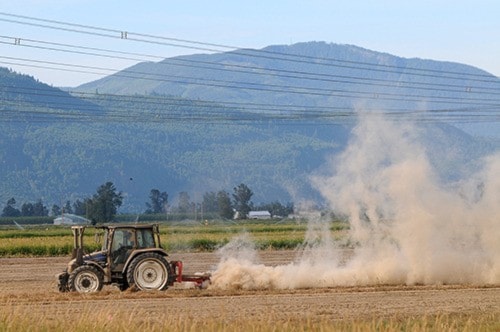by Laura Rodgers, Abbotsford News
So far, this is the second-hottest summer on record for Abbotsford, according to Environment Canada. It was also the ninth-driest, as of Aug. 27.
The mean temperature for June, July and August so far was 18.8 degrees C this year, a number that hasn’t been beaten since 1958, when the mean was 19.1.
The nearly record-breaking hot, dry weather had wide-ranging effects all over the community — from farming troubles to municipal water shortages.
Smaller-than-usual snowpack levels, combined with the lack of rain, caused a shortage in the Abbotsford-Mission municipal water supply, which led to Stage 3 water-usage restrictions starting July 3.
Officials speculated that it might be necessary to escalate to Stage 4, which gives the municipalities emergency powers to restrict water usage as they see fit, by mid-August. However, demand decreased by 9%, and this wasn’t necessary.
“The demand is way down. We’re good,” said city spokesperson Katherine Treloar.
The restrictions ban all use of sprinklers and non-recirculating fountains. Plant watering and car washing is still allowed using a spring-loaded hose nozzle.
While 261 first warning notices were issued in Abbotsford during the first two weeks of the restrictions, only 20 more have been given since. There were also 12 second warnings given in the first two weeks and 15 since. Only one fine has been issued, for $100.
The City of Abbotsford reduced or stopped watering for its soil-grown grass playing fields, though sand-grown grass fields were still watered because they are more delicate. Treloar said repair and reseeding will be needed for some fields, but it will be minimal.
In the District of Mission, there have been 24 warning tickets since Stage 3 restrictions began, and one fine.
But while yellow lawns and dried-out gardens were a sacrifice many locals were ready to make, those who rely on farming for their livelihoods were hit particularly hard by this summer’s conditions.
Sonja Barker, who farms mainly fruits and berries with her husband in Mission’s Silverdale area, said the hot, dry weather has brought a host of problems. Barker also sits on the board of the Fraser Valley Farm Direct Marketing Association.
The warm temperatures hit her strawberry crop hard, causing it much of it to ripen early with useless fruit. “We had thousands of strawberries that were very small and malformed,” said Barker. “Shriveled-up little berries, they turned red before they could put on size.”
Cherries ripened early, many apples were sunburnt and unusable. She had to dump close to a thousand pounds of spoiled or unsaleable fruit. Because of last year’s mild winter, pests like aphids weren’t killed off by the cold, and they swarmed her cabbage and kale.
The far-reaching dryness brought upon the area made watering less efficient — any water she put on the land would seep away quickly to surrounding areas. “It’s heartbreaking…it’s very difficult in these conditions,” said Barker. “It’s very stressful…you’re always at the mercy of Mother Nature.”
But the weather turned the corner starting Aug. 28, when a low-pressure trough from the west replaced the high-pressure ridge that’s been hanging over much of the province for months. There are days of rain forecast, but they won’t be enough to bring river, groundwater and moisture levels back to normal yet.
“Every drop in the bucket helps. This will be the first significant rain since the beginning of June,” said Lisa Coldwells, a meteorologist with Environment Canada.
She said the Fraser Valley region has a large rainfall deficit from this summer so far — while the 40 mm predicted for this weekend will be a big help, it won’t fix everything.
